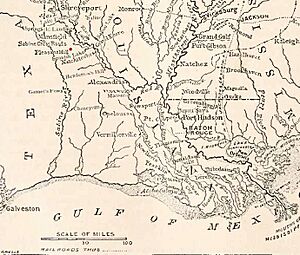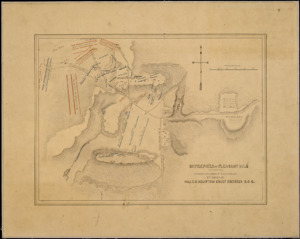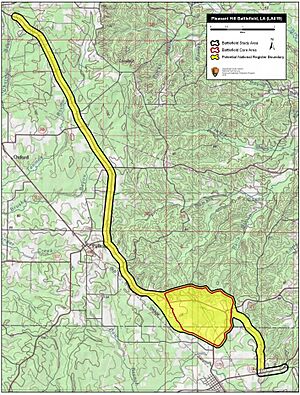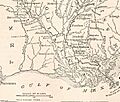Battle of Pleasant Hill facts for kids
Quick facts for kids Battle of Pleasant Hill |
|||||
|---|---|---|---|---|---|
| Part of the Trans-Mississippi Theater of the American Civil War |
|||||
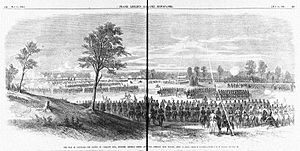 Battle of Pleasant Hill by C. E. H. Bonwell — as illustrated in Frank Leslie's Weekly, May 14, 1864 |
|||||
|
|||||
| Belligerents | |||||
| Commanders and leaders | |||||
| Units involved | |||||
| Army of the Gulf | Trans-Mississippi Department | ||||
| Strength | |||||
| 12,000 | 12,100 | ||||
| Casualties and losses | |||||
| 1,369 total 150 killed 844 wounded 375 missing |
~1,626 total ~1,200 killed and wounded 426 captured |
||||
The Battle of Pleasant Hill took place on April 9, 1864. It was a key part of the Red River Campaign during the American Civil War. Union forces aimed to capture Shreveport, which was the capital of Louisiana at the time.
This battle was a direct follow-up to the Battle of Mansfield, where the Confederates had won. After that loss, the Union commander, Major General Nathaniel P. Banks, sent many of his wagons and artillery (big guns) away. Both sides received more soldiers overnight. When Confederate Major General Richard Taylor attacked the Union lines, his forces were pushed back. However, both sides lost many soldiers. The Union army retreated the next day. Most historians agree that the Union won this battle, but some see it as a tie.
Contents
Why the Battle Happened: Background
After the Confederates won the Battle of Mansfield on April 8, 1864, Union forces pulled back. They moved during the night and set up new positions at Pleasant Hill the next morning. The road from Mansfield to Pleasant Hill was filled with burning wagons and gear left behind by the retreating Union soldiers.
Pleasant Hill was about 16 miles (26 km) southeast of where the Battle of Mansfield happened. Both sides got more soldiers before the Battle of Pleasant Hill. Confederate reinforcements, like Churchill's and Parson's Divisions, arrived late on April 8. They had not fought in the Battle of Mansfield, but they would be very important at Pleasant Hill.
The Union side also received fresh troops. Major General Andrew J. Smith arrived with his soldiers on the evening of April 8. He set up camp about 2 miles (3.2 km) from Pleasant Hill.
On the morning of April 9, the Union army sent its supply wagons and many artillery pieces away from Pleasant Hill. This left fewer big guns for the battle. The wagons moved slowly and were still close by when the fighting started.
The Union army had lost 18 artillery pieces at the Battle of Mansfield. These captured guns were then used by the Confederates against the Union forces at Pleasant Hill. Confederate General Jean Jacques Alexandre Alfred Mouton was killed at Mansfield. General Camille J. de Polignac took command of Mouton's forces at Pleasant Hill.
One Union group fighting at Pleasant Hill was the 47th Pennsylvania Infantry Regiment. They were the only regiment from Pennsylvania in the 1864 Red River Campaign. Many of their soldiers were captured by Confederates. These prisoners were sent to Camp Ford in Texas, a large Confederate prison.
Where the Battle Took Place: The Battlefield
In 1864, Pleasant Hill was a small village with about a dozen houses. It was located on a cleared area in the middle of pine forests. A new town later grew up nearby, closer to the railroad, and took the same name. The original village is now called "Old Pleasant Hill."
A doctor who was there described Pleasant Hill as "a town of about twelve or fifteen houses, situated on a clearing in the woods." The area was mostly pine forests and scrub oaks. The battlefield itself was a large, open field that used to be farmed but was then covered in weeds. A slightly raised area in the center gave the place its name, "Pleasant Hill."
Historian John Winters noted that Pleasant Hill offered good battle advantages. However, it was far from Union supplies and lacked enough drinking water for a large army. Because of this, the Union army could not stay there for long.
Who Fought: Opposing Forces
The main commanders in the Battle of Pleasant Hill were:
| Commanders |
|---|
|
The Battle Itself
Union Major General Nathaniel P. Banks reported that Confederate forces started checking out their new position around 11 a.m. on April 9. They began light skirmishes (small fights) in the afternoon.
At 5 p.m., the Confederates launched a full attack across the entire Union line. Their attack on the Union right side did not succeed much. However, the initial charge by the Confederates was very strong. They pushed back many Union positions in the center and left. But the Union forces managed to stop the attack. They then pushed the Confederates back and drove them from the field.
The battle was very fierce and lasted about two hours. Both sides suffered many losses. The 32nd Iowa Infantry had especially heavy casualties. They were cut off from the rest of the Union forces during the fight.
Confederate General Hamilton P. Bee led two regiments quickly down the Pleasant Hill road. They were suddenly attacked by Union soldiers hidden behind a fence. Many men and horses were hit. General Bee had two horses shot from under him. The Confederates were able to pull back, but they left many dead or wounded soldiers behind.
Just a few hours after the battle ended, at 1 a.m. on April 10, Banks and his Union army began their retreat from Pleasant Hill.
What Happened Next: Aftermath
Confederate General Hamilton P. Bee reported that his forces were in control of the battlefield at daylight on April 10. He said they spent the day burying the dead from both armies and caring for the wounded Union soldiers. Confederate wounded had been cared for the night before.
Many Union soldiers were captured during the battle. They were sent to Camp Ford, a Confederate prisoner-of-war camp near Tyler, Texas. Most were held there for about a year until a prisoner exchange happened near the end of the war.
After the Battle of Pleasant Hill, Banks and his Union forces retreated to Grand Ecore. They gave up their plans to capture Shreveport. Some wounded soldiers were taken to Minden for treatment. Those who died there were buried in the historic Minden Cemetery. Markers were placed for them on March 25, 2008, by the Sons of Confederate Veterans.
Most historians believe the Battle of Pleasant Hill was a Union victory, even though the Union army retreated afterward. Some historians consider it a draw.
The failure of the Red River Campaign was good news for the Confederacy during a difficult year. Even though the Confederates lost resources, including General Tom Green (who was killed on April 12), this Union failure helped to make the war last longer. It kept Union resources busy in Louisiana instead of other battlefronts.
Images for kids


